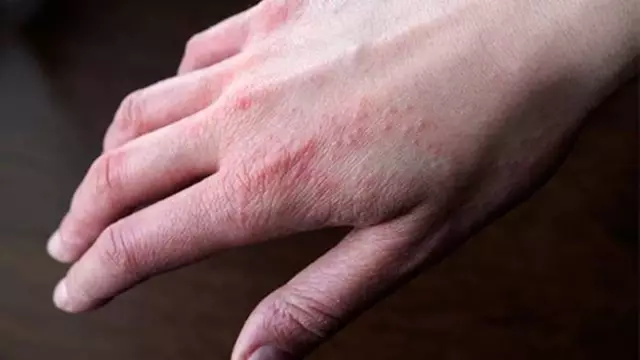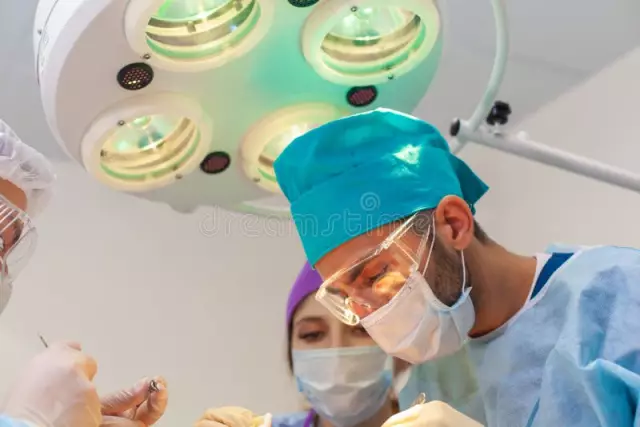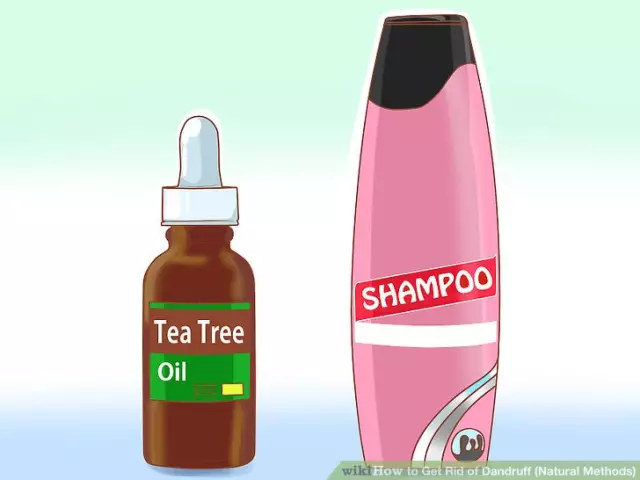- Author Rachel Wainwright [email protected].
- Public 2023-12-15 07:39.
- Last modified 2025-11-02 20:14.
Psoriasis
Brief description of the disease

Psoriasis (scaly lichen) manifests itself as red scaly patches and the appearance of silvery scales on the surface of the skin. These scales constantly itch and give a person very noticeable discomfort. As a rule, the disease affects areas of the skin on the head, elbow and knee joints, in the lower back. Psoriasis of nails, external genital organs and joints is also known, however, these forms are much less common in comparison with skin lesions.
The disease is associated with a short cell life cycle. In a healthy person, the skin is renewed every 30 days. Psoriasis, the symptoms of which are quite pronounced, reduces this period to 4-5 days. As a result, skin cells quickly die, leaving behind keratinized areas.
Psoriasis on the scalp and skin looks like a lot of papules that rise above the surface of the skin. They are covered with silvery scales, have a pink or red color, and easily fall off when combing. Over time, the papules merge into larger formations - plaques and affect more and more areas of the skin.
Considering that 2-7% of the working-age population is diagnosed with psoriasis, the treatment of this disease is a very urgent medical problem. The main difficulty here lies in the fact that the reasons for the rapid death of cells have not yet been studied. Some researchers associate this process with disorders of the immune system, others with poor heredity. There are also theories that explain the appearance of plaques by improper diet, climatic conditions and stress. Most likely, all these factors coincide, triggering the disease mechanism.
Psoriasis - symptoms and clinical picture
Symptoms usually come on suddenly. First, multiple pink rashes appear on the patient's body, which quickly spread over a very large area. Then the papules that appear increase in size and form larger stains. At the same time, the damaged skin constantly bleeds and cracks. Psoriasis of nails manifests itself in a completely different way. With it, the nail plates become cloudy, small and large grooves or punctate indentations appear on them.
The main symptom of psoriasis is itching. It is especially strongly felt in places of large accumulations of papules, but it also affects the nearby areas of the skin. Note that psoriasis, the symptoms of which intensify in winter, may subside for no apparent reason, but never completely disappears, so at the first signs of the disease, you need to consult with your doctor and undergo a full examination.
If you do not treat psoriasis (alternative treatment is permissible along with traditional medical methods), then over time it will become severe and will be accompanied by damage to the joints. They will begin to lose mobility, swelling and pain. At the same time, many patients complain of instability of the emotional state. However, this is understandable, because the disease significantly reduces the standard of living and affects the psychological state of people.
Psoriasis - treatment with traditional methods

I would like to say right away that at the moment there is no guaranteed way to get rid of psoriasis, but the medical industry produces a fairly large set of tools that will help control the spread of the disease and reduce the severity of its symptoms. Keep in mind that psoriasis, whose symptoms tend to improve depending on a variety of factors, never goes away on its own. Even if it has passed into a latent form, the skin continues to experience minor functional, immunological and biochemical changes.
If a person is diagnosed with psoriasis, treatment should be comprehensive and include the use of the most effective techniques:
- the use of hormonal drugs that are applied to damaged skin. Products such as Diprosalik, Schering-Plow, Elokom, Betamethasone and Flucionolone have proven themselves well. Keep in mind that the frequency of use of these drugs should be determined by a competent doctor, since if uncontrolled treatment, hormonal drugs can cause dry skin, contact dermatitis, allergic reactions and secondary infections.
- ultraviolet irradiation (UFO) - with the correct use of psoriasis, the treatment of which is carried out by the UFO method, ceases to spread over the surface of the skin with a simultaneous attenuation of previously expressed symptoms;
- photochemotherapy is one of the most effective methods of treating psoriasis, especially in severe forms of the disease. The therapeutic effect is based on the effect on the skin of long-wave UV rays and the intake of drugs of the photosensitizing group: puvalen, psoralen, ammifurin, methoxypsoragen. Photochemotherapy allows you to get rid of 80% of plaques, and with regular use, it destroys 90-95% of skin deformities;
- in recent years, psoriasis of the scalp and skin of other parts of the body has been successfully treated with laser therapy. The laser beams excite living tissue molecules, cause photochemical, photomechanical and other positive effects.
In addition to the above methods, psoriasis is treated with X-ray therapy, ultrasound, phonophoresis, electrotherapy, magnetic waves and low temperatures. Good results are shown by thalassotherapy, which not only strengthens the body's defense systems, but also gives the patient extremely pleasant emotions.
Psoriasis - treatment with folk remedies
There are many recipes to help get rid of this unpleasant disease. We will tell you only about the most popular of them, which have actually proven their effectiveness.
- 20 g of dry bay leaves are poured over with 2 cups of boiling water. The broth reaches the condition over low heat for 10-15 minutes, after which it is filtered and cooled. The medicine must be taken 3 times a day for 1/3 cup;
- a person who has been diagnosed with psoriasis, alternative treatment suggests taking baths from a string, St. John's wort, celandine, sage or fir extract;
- collections from the herbs of a string, St. John's wort, elecampane roots, elder flowers and horsetail grass are very effective. A tablespoon of the collection is poured with a glass of boiling water and infused in a water bath for 15-20 minutes. The infusion should be taken in the morning and evening immediately after meals;
- Another remedy for psoriasis is sea buckthorn oil. It is taken internally, one teaspoonful once a day;
- flowers and leaves of black elderberry have a strong effect. Pour 0.5 liters of boiled water over two teaspoons of the plant and leave for an hour. Then the broth is filtered. It must be stored in a cool, dry place, and taken 3 times a day, 1/3 cup.
For external use, we can recommend celandine juice, fish oil and garlic tincture. Lubricate the affected skin with them once or twice a day. Trays made from corn or oat flour are also recommended. For people who have been diagnosed with psoriasis, treatment with folk remedies is often the only option for solving skin problems.
YouTube video related to the article:
The information is generalized and provided for informational purposes only. At the first sign of illness, see your doctor. Self-medication is hazardous to health!






